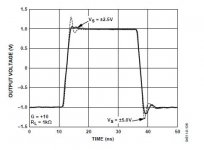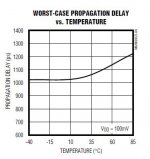Just remember Sy knows all
Yeah , but he speaks in Null .................
Sy,
Propagation delay in typical Op-Amp type structures is several microseconds, even fully uncompensated comparators usually have propagation delays in the 100's of nanoseconds.
Ciao T
Better tell the guys doing 40G Ethernet, we have plenty of comparators with 10's of femto-sec delay. There are dozens of op-amps with nsec closed loop delay, maybe your talking about open-loop? Please explain, input on fig below was applied slightly after 10ns (I could get an exact number)?
I think I should stay out of this tired topic. The confusion of accumulated phase vs true delay (non-minimum phase portion) just keeps coming up just like the feedback going around and around.
Attachments
Last edited:
Let me try to explain the problem of delay vs feedback, if I can. First of all, a NON-COMPENSATED open loop amp would be fairly fast, uS to nS, fast enough for just about everybody. However, when you add DOMINANT POLE COMPENSATION, the open loop delay usually gets VERY LONG. Now, why do we NOT see this delay with the application of lots of feedback? The application of feedback, SHORTENS the effective delay by OVERDRIVING the input stage. This moves the bandwidth from, let's say: 10 Hz to 1MHz, for example. This also increases the internal transient overshoot, 100,000 times, as well. Gee, think that there might be a potential problem, at least sometimes?
The original mathematics for this was best expressed by Daugherty (sp) and Greiner, in an IEEE paper in 1966. Anybody have this article? Great math, originally footnoted by Otala in 1970, in one of his papers.
In a 'nutshell' the input stage is 'overdriven' by whatever it takes to get the output to match the input, to the extent of how much global loop feedback you are applying, up to the limit of slew rate limiting, when the model fails.
The original mathematics for this was best expressed by Daugherty (sp) and Greiner, in an IEEE paper in 1966. Anybody have this article? Great math, originally footnoted by Otala in 1970, in one of his papers.
In a 'nutshell' the input stage is 'overdriven' by whatever it takes to get the output to match the input, to the extent of how much global loop feedback you are applying, up to the limit of slew rate limiting, when the model fails.
Not following you Sy .....WaveB ...Modulation ..?
Yep.
Suppose you have an American football (non-round). In order to make it round (linear) you squeeze it. What happens to it's width? The same happens with vectors when you correct amplitude and frequency response using feedback.
I think I should stay out of this tired topic. The confusion of accumulated phase vs true delay (non-minimum phase portion) just keeps coming up just like the feedback going around and around.
No need to confuse: true delay as well is caused by inertia.
The confusion of accumulated phase vs true delay (non-minimum phase portion) just keeps coming up just like the feedback going around and around.
Truer words... but if you allow that people can redefine standard terms any way they like, what the heck, that's democracy.
Interesting, Wavebourn.
Actually, it is rather 3-d snail than a ball.
Edit: but I believe 3-d math modeling can be used to represent amplitude, phase, and frequency dependence of gain. It would be interesting and useful, to show people who have no scientific background in electronics.
Last edited:
Scott,
There are many interesting things, though those femtosecond delay comprators must have escaped my notice. What is the part number?
Also, for your plot, what is the part number?
Ciao T
Better tell the guys doing 40G Ethernet, we have plenty of comparators with 10's of femto-sec delay. There are dozens of op-amps with nsec closed loop delay, maybe your talking about open-loop?
There are many interesting things, though those femtosecond delay comprators must have escaped my notice. What is the part number?
Also, for your plot, what is the part number?
Ciao T
I just grabbed an AD8099 plot there are faster. The comparators/lim-amps are buried inside networking products, one will be featured in Jan. Electronics Products (I'm under gag order)Scott,
There are many interesting things, though those femtosecond delay comprators must have escaped my notice. What is the part number?
Also, for your plot, what is the part number?
Ciao T
EDIT - Maxim part, 1nsec
Attachments
Last edited:
Scott,
Yes. And the GBWP on this part is 3,800MHz.
Too bad. Non in SOT23-5 or similar? I'll settle for picoseconds...
Ciao T
I just grabbed an AD8099 plot there are faster.
Yes. And the GBWP on this part is 3,800MHz.
The comparators/lim-amps are buried inside networking products, one will be featured in Jan. Electronics Products (I'm under gag order)
Too bad. Non in SOT23-5 or similar? I'll settle for picoseconds...
Ciao T
I prefer to bear in mind that English is not the first language of several participants in this discussion, and find it more useful to try to understand what people mean by their words, rather than insulting their exact choice of words, without providing any clarification. Doing the latter simply derails the discussion without helping anybody's understanding of anything.Truer words... but if you allow that people can redefine standard terms any way they like, what the heck, that's democracy.
So far I gather that the correct term for the delay referred to by Thorsten & co is not "propagation delay". Apparently "propagation delay" is true (non-minimum phase) delay, such as with a delay line, as opposed to the apparent delay caused by phase shift e.g. in a simple RC low-pass filter.
Now, what is the correct name for the kind of delay Thorsten was talking about? Is that "group delay", or is it something else again?
Last edited:
Well stated Godfrey. Of course, here in America, I we don't seem to speak English either. We are reduced to letters of about 42 characters even when verbalizing.
Might I refer you to WIKI.
Group delay and phase delay - Wikipedia, the free encyclopedia
Might I refer you to WIKI.
Group delay and phase delay - Wikipedia, the free encyclopedia
Of course, here in America, I we don't seem to speak English either.

Thanks for the link. I'll go have a look.
Let me try to explain the problem of delay vs feedback, ..... global loop feedback you are applying, up to the limit of slew rate limiting, when the model fails.
Ah, so this is why the emphasis on input stage bandwidth way in excess of the audible range. The mechanism was not clear. Is there a target rule of thumb, like 5 x, or is a matter of as much as the price point will allow? So,the complete amplifier bandwidth should be limited by the input low pass filter. Simplified of course.
That brings up another question. I worked out the input LP filters on several amps I have. They all seem to be in the 140Khz range. Yet the published bandwidth ranged from 40K to 120Khz. Is there a good technical reason, or is this driven by spec sheet competition? I guess I would have picked something like 80K without any other knowledge than to limit ultrasonics bothering the amp and to keep any filter effects a couple octaves away from the signal.
Looking forward to my Amazon order.
Depends if you're talking about small signal frequency response or power bandwidth. Just because the frequency response extends to 140KHz doesn't mean the amp can produce full power up to that frequency. Max output could be reduced at high frequencies e.g. by slew rate limiting or fear of burning the resistor in the zobel network.I worked out the input LP filters on several amps I have. They all seem to be in the 140Khz range. Yet the published bandwidth ranged from 40K to 120Khz.
Dear Sy,
In all the definitions I find the kind of delay caused by an RC Lowpass is included in the definition of propagation, as it is in the end concerned only with when a certain quantity reaches the receiver, it does not investigate the causes of the delay and excludes any it dislikes.
But arguably the definition of propagation delay varies somewhat between disciplines and interpreters.
Ciao T
Phase delay is a standard physical term used by engineers internationally.
In all the definitions I find the kind of delay caused by an RC Lowpass is included in the definition of propagation, as it is in the end concerned only with when a certain quantity reaches the receiver, it does not investigate the causes of the delay and excludes any it dislikes.
But arguably the definition of propagation delay varies somewhat between disciplines and interpreters.
Ciao T
Scott,
Yes. And the GBWP on this part is 3,800MHz.
Too bad. Non in SOT23-5 or similar? I'll settle for picoseconds...
Ciao T
I did mis-speak, I meant to say 10's of pico-sec femto next gen. I was wondering about re-purposing some of the 10G Ethernet parts in an optical SPDIF, the main problem is getting them to work that slow.
- Status
- Not open for further replies.
- Home
- Member Areas
- The Lounge
- Sound Quality Vs. Measurements

